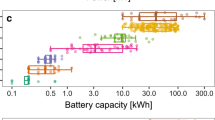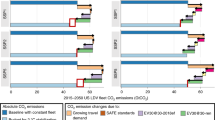Abstract
Reducing vehicle weight is an important avenue to improve energy efficiency and decrease greenhouse gas emissions from our cars and trucks. Conventionally, models have estimated acceptable increased manufacturing cost as proportional to the lifetime fuel savings associated with reduced vehicle weight. Vehicle lightweighting also enables a decrease in powertrain size and significant reductions in powertrain cost. Accordingly, we propose and apply a method for calculating the maximum net benefits and breakeven cost of vehicle lightweighting that considers both efficiency and powertrain downsizing for a conventional internal combustion engine vehicle, a battery electric vehicle with a range of 300 miles (BEV300), and a fuel cell electric vehicle (FCEV). We find that excluding powertrain downsizing cost savings undervalues the potential total net benefits of vehicle lightweighting, especially for the BEV300 and FCEV.



Similar content being viewed by others
References
W.J. Joost, JOM 64, 1032 (2012). doi:10.1007/s11837-012-0424-z.
A. Mascarin, T. Hannibal, A. Raghunathan, Z. Ivanic, and J. Francfort, Vehicle Lightweighting: 40% and 45% Weight Savings Analysis: Technical Cost Modeling for Vehicle Lightweighting. Idaho National Laboratory: INL/EXT-14-33863 (2015). doi:10.2172/1186760.
H. Hakamada, T. Furuta, Y. Chino, Y. Chen, H. Kusuda, and M. Mabuchi, Energy 32, 1352 (2007). doi:10.1016/j.energy.2006.10.020.
Y.S. Song, J.R. Youn, and T.G. Gutowski, Compos. A 40, 1257 (2009). doi:10.1016/j.compositesa.2009.05.020.
R.A. Witik, J. Payet, V. Michaud, C. Ludwig, and J.-A.E. Manson, Compos. A 42, 1694 (2011). doi:10.1016/j.compositesa.2011.07.024.
A.T. Mayyas, A. Qattawi, A.R. Mayyas, and M.A. Omar, Energy 39, 412 (2012). doi:10.1016/j.energy.2011.12.033.
H.C. Kim and T.J. Wallington, Environ. Sci. Technol. 47, 6089 (2013). doi:10.1021/es3042115.
U.S. Environmental Protection Agency, Light-Duty Vehicle Mass Reduction and Cost Analysis—Midsize Crossover Utility Vehicle: EPA-420-R-12-026 (2012).
N.P. Lutsey, Review of technical literature and trends related to automobile mass-reduction technology. University of California, Davis: UCD-ITS-RR-10-10 (2010).
D. MacKenzie, S. Zoepf, and J. Heywood, Int. J. Veh. Des. 65, 73 (2014). doi:10.1504/IJVD.2014.060066.
A. Moawad, N. Kim, N. Shidore, and A. Rousseau, Assessment of Vehicle Sizing, Energy Consumption and Cost through Large Scale Simulation of Advanced Vehicle Technologies. Argonne National Laboratory: ANL/ESD-15/28 (2016). doi:10.2172/1245199.
National Research Council, Cost, Effectiveness, and Deployment of Fuel Economy Technologies for Light-Duty Vehicles (2015). doi:10.17226/21744.
Author information
Authors and Affiliations
Corresponding author
Electronic supplementary material
Below is the link to the electronic supplementary material.
Rights and permissions
About this article
Cite this article
Ward, J., Gohlke, D. & Nealer, R. The Importance of Powertrain Downsizing in a Benefit–Cost Analysis of Vehicle Lightweighting. JOM 69, 1065–1070 (2017). https://doi.org/10.1007/s11837-017-2330-x
Received:
Accepted:
Published:
Issue Date:
DOI: https://doi.org/10.1007/s11837-017-2330-x




